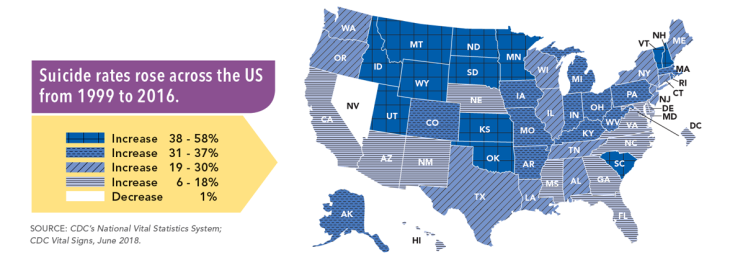
On June 7, 2018, CDC informed America that not only are we dealing with an opioid crisis, we also have a suicide crisis. It told us that:
- U.S. suicide rates rose by nearly 30% between 1999 to 2016
- Nearly 45,000 lives were lost to suicide in 2016
- In half the states the increase was greater than 30%
- More than half — 54% — of those who died of suicide did not have a known mental health condition.
Let’s dig a little deeper. I am particularly interested that 54% number, in the most common means of suicide and relationship between suicide and substance use.

First the 54%. It’s easy to jump to the conclusion that more than half of individuals who died of suicide had no mental illness. However, as one sees in the above image, of those who died of suicide and had no known mental health condition, 84% were men. We know that generally men are less likely to seek healthcare in general and mental healthcare in particular. So the fact that are 84% of the people do not have a “known” mental illness could mean that they have no mental illness or more likely, that they have a mental illness but it has not been diagnosed. The fact that over 20% of those without a known mental health condition tested positive for antidepressants gives support to the latter conjecture. The 54% figure appears to be driven primarily by men. Men are also the majority — 69% — in the group with a known mental health condition. Essentially, men are driving the overall suicide death rates.
Second, in both groups — the ones with a known mental health condition and those without — firearms were the most common means of suicide. Let’s a look at the map provided by CDC showing the differences between states as far as the percentage increases in suicide rates are concerned.

And let’s compare this graphic with that comparing gun ownership rates across the states.

It’s not a 100% overlap but there is significant overlap between states’ suicide rate increases and their gun ownership rates. I have long realized that the it is impossible to prevent any discussion about health policy implications of gun ownership in the US from devovling into a shouting match. Therefore, I refuse to get into a debate about it. However, the loose correlation is still worth a mention as it shows that firearm access appears to a factor behind suicide rates.
Finally, if we dig in the detailed report behind the headlines, we find that not every suicide death was followed by toxicology testing, but when it was, of those tested for alcohol — whether with known or no known mental health condition — about 40% were positive. 25-30% of those tested for opioids were positive and 20-40% of those tested for a class of sedating medications called benzodiazepines tested positive. To those working in mental health, substance use has long been known as a risk factor for suicide. This report suggests that at least 40% of suicides had alcohol involved in the picture and assuming some overlap between different substances used, 50% or more had some substance use around the suicide.
Obviously these are correlations from which definitive causal conclusions must not be drawn, but it appears that men, substance use and access to guns are important factors underlying American’s suicide rates.
